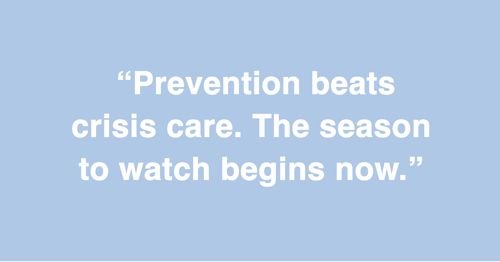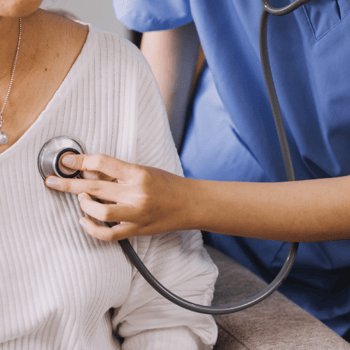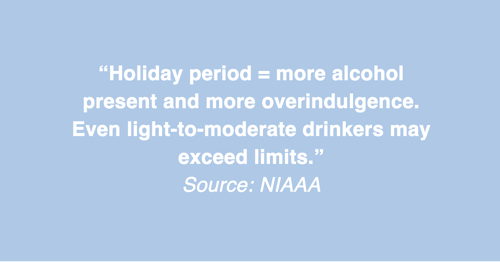I’ve worked with so many clients who’ve spent years in therapy or treatment without real...
Halloween to New Year’s: the hidden relapse curve providers should know
For many, the stretch from Halloween through New Year’s is a time of celebration, gatherings, family traditions, and social events that fill calendars and lift spirits. But for individuals in recovery, this same season can quietly become one of the highest-risk periods of the year. Starting as early as late October, the combination of increased alcohol availability, social pressure, disrupted routines, and emotional stress begins to build. By Thanksgiving, that curve is already rising, and by December, relapse rates, emergency visits, and crisis calls often peak. This predictable seasonal pattern offers an important opportunity for clinicians and care teams: to identify risks early, screen proactively, and coordinate medical and behavioral support before the pressure of the holidays intensifies.
At Kai Shin Clinic, our message to providers and partners is simple: anticipate the curve before it crests.

Why the curve begins earlier than many expect
- Social normalization spikes first. Halloween parties mark the start of a months-long stretch when alcohol is more present than usual and many people drink beyond their limits. The National Institute on Alcohol Abuse and Alcoholism notes that the holidays are a time when even those who do not usually drink may overindulge, with consequences ranging from falls to traffic crashes. NIAAA+1
- Emotional and environmental stressors accumulate. Shorter daylight and colder weather are linked to increased depressive symptoms in fall and winter, which can amplify cravings and reduce coping bandwidth for people in recovery. PMC
- Clinical impact shows up in urgent care. Health systems and public-health agencies consistently report increases in alcohol-related harm and ER visits during the holiday period, with impaired-driving crashes and alcohol-related presentations rising into late December. UCLA Health+1
What to watch for in clinic between now and January
Ask brief seasonal questions during visits.
- “Any upcoming events where alcohol will be present?”
- “What tends to be hardest for you during the holidays?”
- “Who is in your support circle for the next few months?”
Screen for medical contributors to relapse vulnerability.
- Fatigue, sleep disturbance, pain flare, or mood symptoms that worsen with season change.
- Nutrition issues or metabolic red flags that can be identified with basic labs when clinically appropriate.
- Refill continuity for medications, including MAT, as schedules get disrupted.
Expect more acute alcohol-related presentations.
- Health systems report increased alcohol-related ED visits and injuries during the holidays. Prepare for brief interventions, safe-use counseling, and linkage back to outpatient care. UCLA Health+1

Practical steps that reduce risk
1) Proactive touchpoints now through New Year’s
- Short follow-ups for higher-risk patients.
- Earlier MAT check-ins and refills to prevent gaps.
- Quick messages or patient-portal nudges about planning for events.
2) Tighten medical–behavioral coordination
- Warm handoffs to counseling or peer support before major holidays.
- Shared care plans that include coping strategies and crisis numbers (SAMHSA’s helpline is 24/7). SAMHSA+1
3) Brief education that resonates
- NIAAA holiday materials emphasize that over-drinking is common this season and carries immediate risk. Use one minute to normalize planning alternative beverages, exit strategies, and designated-driver arrangements. NIAAA+1
What the evidence and experience suggest
- Relapse risk is persistently high after treatment. Meta-summaries report substantial relapse rates after intensive programs, underscoring why seasonal prevention matters. NCBI
- Holiday-related harms are predictable. Public-health and health-system reports repeatedly show more alcohol-related ED visits and injuries in late-year holidays. Clinicians can mitigate risk with anticipatory guidance and rapid linkage. UCLA Health+1
- Mood seasonality is not trivial. Fall/winter depressive patterns can worsen craving and reduce resilience, especially when routines change. Screening and simple interventions help. PMC
Quick resources for clinicians
- NIAAA holiday guidance on alcohol risks for patient education and clinician messaging. NIAAA+1
- SAMHSA holiday resource pages and 24/7 helpline for mental health and substance use support. SAMHSA+1
- Peer-reviewed summary on relapse prevention for context when discussing risk windows with patients and teams. NCBI
A clinical mindset for a predictable season
The holiday period is not a single peak. It is a rising curve that often begins now. Teams that plan for it with brief screening, coordinated supports, and a bit of calendar discipline help patients avoid crises and keep recovery momentum. If you have a patient in need of support, contact us now here!


.jpg?height=200&name=vecteezy_man-with-mental-health-problems-is-consulting-psychiatrist_25025778%20(1).jpg)
